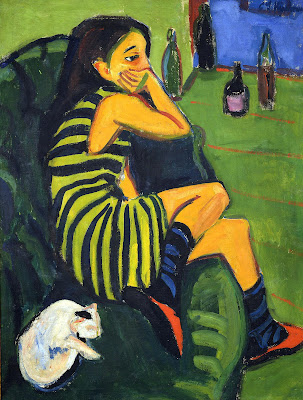“Sally Bowles” by Christopher Isherwood and Kirchner's German
Expressionism
Christopher Isherwood's “Sally Bowles” paints the story of a nineteen year old actress from England living in Berlin in 1930. A cabaret singer hoping to find fame, Sally also makes lovers of older, wealthy men. While Sally did not have a particularly womanly figure, she wore crimson lipstick, heavy eye makeup, eyebrow penciling and powdered her face to compensate. The narrator comments that he sees Sally wearing black most of the time, which blends in with her dark hair; he also remarks on the detail of her green-painted fingernails. If she sounds familiar, it's because Sally also appears in Cabaret.Ernst Kirchner belonged to the group of German Expressionists known as Die Brücke (The Bridge). The group focused on expressing concentrated emotion through their use of color, which tended to be unnatural, lending itself to a more abstract feel. In addition to emotion, the group often painted with sexual themes.
The ties between this German Expressionist movement and Sally can be seen through both Kirchner and Isherwood's deliberate use of color, and through the sexualization of a young woman, still with a boyish body. In Kirchner's paintings Marzella (1909-10) and Artistin Marcella (1910), a young woman is painted in two different ways.
 |
| Marzella by Ernst Kirchner (German); 1909-1910; oil. Location: Stockholm, Sweden; Moderna Museet. |

|
 |
| Artistin Marcella by Ernst Kirchner (German); 1910; oil. Location: Berlin, Germany; Brücke Museum. |

|
In relating both paintings directly to the character of Sally Bowles, it is possible to conceive that the second painting is Sally before she embarks on her journey to reach fame in Berlin, perhaps at her parents' English home, daydreaming. The first painting, more jarring as the girl stares right into the viewer's eyes, could be seen as Sally as the reader knows her—a sexualized girl, attempting to gain a certain lifestyle and wealth through pleasing men—with colors depicting disharmony, having a certain contamination in the tones. Both girls, much like Sally, seem to be looking for something more than the heartache they are familiar with.
Les Demoiselles d'Avignon quite possibly changed my life when I saw it in NYC MoMA, along with Starry Night. :) I love your blog posts Jam.
ReplyDeleteI LOVED seeing it because it is so LARGE. It's like BAM in your face: hookers. :)
ReplyDeleteAlso, thanks! <3